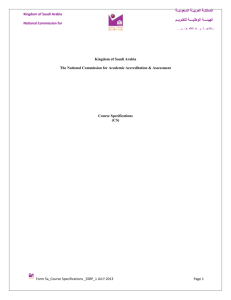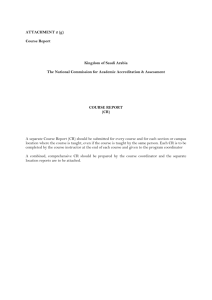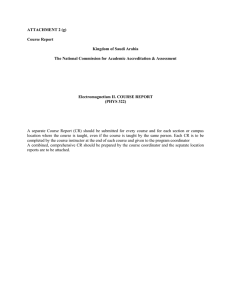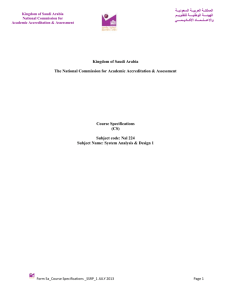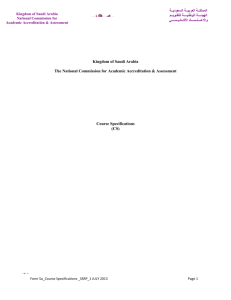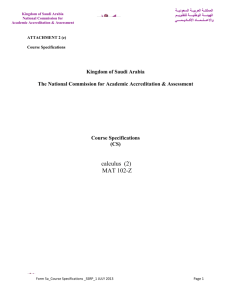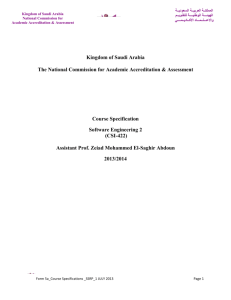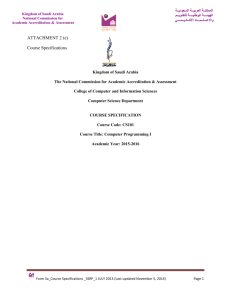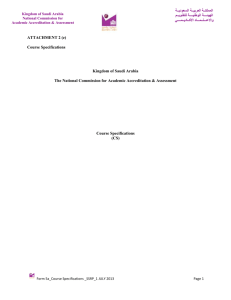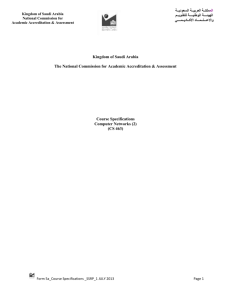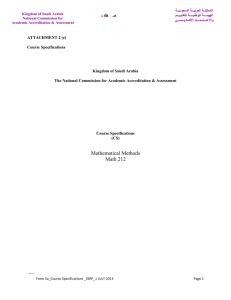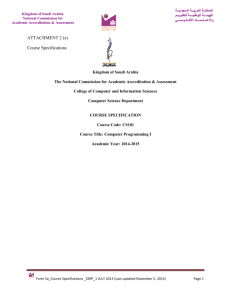Compiler Design
advertisement
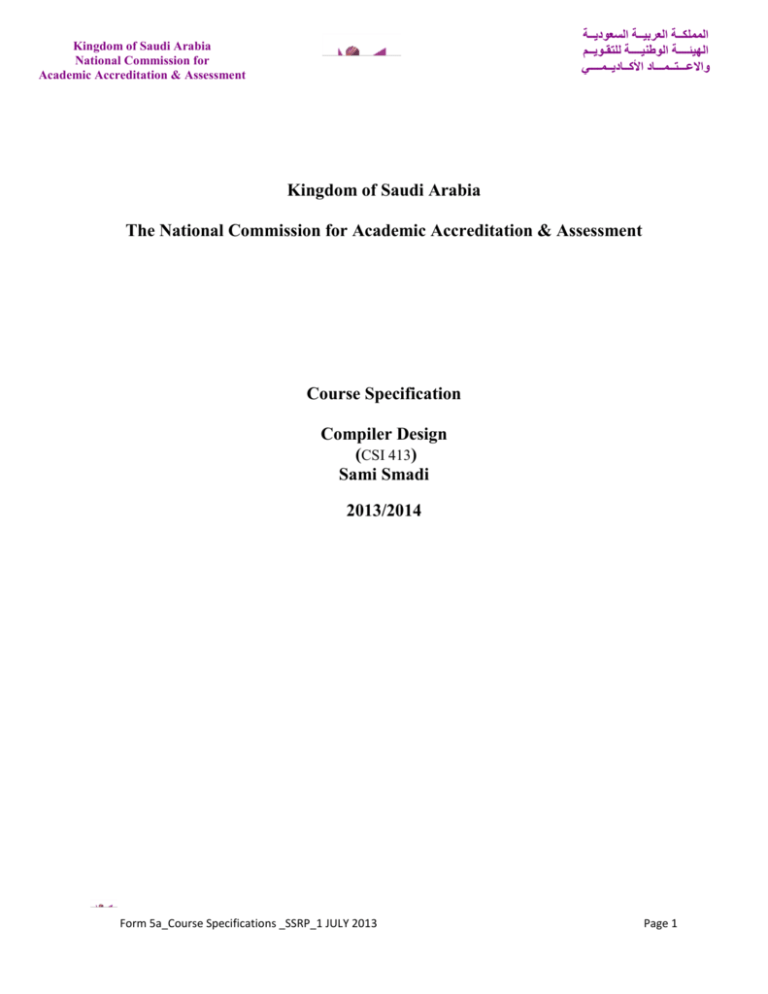
المملكــة العربيــة السعوديــة الهيئــــة الوطنيــــة للتقـويــم واالعـــتــمـــاد األكــاديــمــــي Kingdom of Saudi Arabia National Commission for Academic Accreditation & Assessment Kingdom of Saudi Arabia The National Commission for Academic Accreditation & Assessment Course Specification Compiler Design (CSI 413) Sami Smadi 2013/2014 Form 5a_Course Specifications _SSRP_1 JULY 2013 Page 1 المملكــة العربيــة السعوديــة الهيئــــة الوطنيــــة للتقـويــم واالعـــتــمـــاد األكــاديــمــــي Kingdom of Saudi Arabia National Commission for Academic Accreditation & Assessment Course Specifications Majmaah University Institution: Date of Report: 2013/2014 College/Department: College of Science at Az Zulfi, Department of Computer Science and Information A. Course Identification and General Information 1. Course title and code: Compiler Design (CSI 413) 2. Credit hours: 3 credit hours (2 lecture + 2 Laboratory) 3. Program(s) in which the course is offered. (If general elective available in many programs indicate this rather than list programs) Computer Science and Information Program 4. Name of faculty member responsible for the course Sami Smadi 5. Level/year at which this course is offered: 5th – 2013/2014 6. Pre-requisites for this course (if any): Disc. Math For CS 2 CSI 222, Programming 2 CSI 221 7. Co-requisites for this course (if any): None 8. Location if not on main campus College of Science at Az Zulfi 9. Mode of Instruction (mark all that apply) a. Traditional classroom √ What percentage? 80% b. Blended (traditional and online) √ What percentage? 10% c. e-learning What percentage? d. Correspondence What percentage? f. Other √ What percentage? 10% Comments: One-tenth of the course is presented mainly inside video lectures of other instructors worldwide. They illustrate the same topics that I introduced in my lectures with a different presentation. Form 5a_Course Specifications _SSRP_1 JULY 2013 Page 2 Kingdom of Saudi Arabia National Commission for Academic Accreditation & Assessment المملكــة العربيــة السعوديــة الهيئــــة الوطنيــــة للتقـويــم واالعـــتــمـــاد األكــاديــمــــي B Objectives 1. What is the main purpose for this course? The goal of this course is to introduce the design and implementation of compilers. Topics include: compiler organization, algorithms for lexical, syntactic and semantic analysis, topdown and bottom-up parsing (e.g., recursive descent, LL, LR, LALR parsing), symbol table organization, error detection and recovery, intermediate and object code generation, and code optimization. Student has to implement a compiler for a simple high level language (like mini C) as a project . 2. Briefly describe any plans for developing and improving the course that are being implemented. (e.g. increased use of IT or web based reference material, changes in content as a result of new research in the field) 1. Using group discussion through the internet with course attending students. 2. Updating the materials of the course to cover the new topics of the field. C. Course Description (Note: General description in the form to be used for the Bulletin or handbook should be attached) Form 5a_Course Specifications _SSRP_1 JULY 2013 Page 3 المملكــة العربيــة السعوديــة الهيئــــة الوطنيــــة للتقـويــم واالعـــتــمـــاد األكــاديــمــــي Kingdom of Saudi Arabia National Commission for Academic Accreditation & Assessment 1. Topics to be Covered List of Topics 1. Introduction to Compilers: The role of language translation in the programming process; Comparison of interpreters and compilers, language translation phases, machine-dependent and machine-independent aspects of translation, language translation as a software engineering activity 2. Lexical Analysis: Application of regular expressions in lexical scanners, 3. Lexical Analysis: hand coded scanner vs. automatically generated scanners 4. Lexical Analysis: formal definition of tokens, implementation of finite state automata. 5. Syntax Analysis: Revision of formal definition of grammars, BNF and EBNF; bottom-up vs. top-down parsing, 6. Syntax Analysis: tabular vs. recursive-descent parsers, error handling, 7. Parsers Implementation: automatic generation of tabular parsers, symbol table management, the use of tools in support of the translation process 8. Semantic Analysis: Data type as set of values with set of operations, data types, type- checking models, semantic models of user-defined types, parametric polymorphism, subtype polymorphism, type-checking algorithms. 9. Intermediate Representation, code generation: Intermediate and object code, intermediate representations, implementation of code generators 10. Code generation: code generation by tree walking; context sensitive translation, register use. 11. Code optimization: Machine-independent optimization; data-flow analysis; loop optimizations; machine-dependent optimization 12. Error Detection and Recovery 13. Error Repair, Compiler Implementation 14. Compiler design options and examples: C Compilers 15. C++, Java, and YACC Compilers 16. Project presentation Form 5a_Course Specifications _SSRP_1 JULY 2013 No of Weeks Contac t hours 1 4 4 1 4 1 4 1 4 1 4 1 4 1 4 1 4 1 4 1 4 1 1 1 1 1 4 4 4 4 Page 4 المملكــة العربيــة السعوديــة الهيئــــة الوطنيــــة للتقـويــم واالعـــتــمـــاد األكــاديــمــــي Kingdom of Saudi Arabia National Commission for Academic Accreditation & Assessment 2. Course components (total contact hours and credits per semester): Lecture Tutorial Laboratory Practical Other: Total Contact Hours 30 30 - - 60 Credit 30 15 - - 45 3. Additional private study/learning hours expected for students per week. 5 The private self-study of my student is crucial for this course. It includes: reading carefully the topics in the textbook or reference book, browsing the websites that concerned with the course, solving the exercises that are assigned in each chapter, discussing the course topics with the instructor in his office hours, watching the video lectures of other instructors who presented related topics worldwide. The total workload of the student in this course is then: 60 + 5 * 15 = 135 work hours. 4. Course Learning Outcomes in NQF Domains of Learning and Alignment with Assessment Methods and Teaching Strategy: By the end of this course, students will be able to: 1.0 NQF Learning Domains And Course Learning Outcomes Knowledge 1.1 Understand the structure of compilers 1.2 Understand the basic techniques used in Form 5a_Course Specifications _SSRP_1 JULY 2013 Course Teaching Strategies Lectures Lab demonstrations Case studies Individual presentations Course Assessment Methods Written Exam Homework assignments Lab assignments Class Activities Quizzes Page 5 المملكــة العربيــة السعوديــة الهيئــــة الوطنيــــة للتقـويــم واالعـــتــمـــاد األكــاديــمــــي Kingdom of Saudi Arabia National Commission for Academic Accreditation & Assessment compiler construction such as lexical analysis, top-down, bottom-up parsing, context-sensitive analysis, and intermediate code generation 1.3 Understand the basic data structures used in compiler construction such as abstract syntax trees, symbol tables, three-address code, and stack machines 2.0 Cognitive Skills explain the core issues of Compiler desighn. Design and implement a compiler using a software engineering approach 2.3 identify problems, and explain, analyze, and evaluate various design strategies of compilers. 2.1 2.2 Lectures Lab demonstrations Case studies Individual presentations Brainstorming 3.0 3.1 3.2 Interpersonal Skills & Responsibility 3.3 Present a short report in a written form and orally using appropriate scientific language. 4.0 Communication, Information Technology, Numerical Work in a group and learn time management. Learn how to search for information through library and internet. Communicate with teacher, ask questions, solve problems, and use computers. Use Information technology and computer 4.2 skills to gather information about a selected topic. 4.1 Small group discussion Whole group discussion Brainstorming Presentation Small group discussion Whole group discussion Brainstorming Presentation Written Exam Homework assignments Lab assignments Class Activities Quizzes Written Exam Homework assignments Lab assignments Class Activities Quizzes Written Exam Homework assignments Lab assignments Class Activities Quizzes Operate questions during the lecture, work in groups, and communicate with each other and 4.3 with me electronically, and periodically visit the sites I recommended. 5.0 Psychomotor 5.1 5.2 5. Schedule of Assessment Tasks for Students During the Semester Assessment task (e.g. essay, test, group project, examination, speech, Form 5a_Course Specifications _SSRP_1 JULY 2013 Week Due Proportion of Total Page 6 المملكــة العربيــة السعوديــة الهيئــــة الوطنيــــة للتقـويــم واالعـــتــمـــاد األكــاديــمــــي Kingdom of Saudi Arabia National Commission for Academic Accreditation & Assessment 1 oral presentation, etc.) First written mid-term exam Assessment 6 15% 2 Second written mid-term exam 12 15% 3 Presentation, class activities, and group discussion Every week 10% 4 Homework assignments 10% 5 Practical exam After Every chapter 15 6 Final written exam 16 40% 10% 100% Total D. Student Academic Counseling and Support 1. Arrangements for availability of faculty and teaching staff for individual student consultations and academic advice. (include amount of time teaching staff are expected to be available each week) Office hours: Sun: 8-10, Mon. 8-10, Tus. 1-3. Office call: Mon. 12-1 and Tus 12-1 Email: s.smadi@mu.edu.sa E. Learning Resources 1. List Required Textbooks R Sethi , J D Ullman & Addison-Wesley : Compilers: Principals, Techniques, and Tools, 3rd , 2007, Addison-Wesley. 2. List Essential References Materials (Journals, Reports, etc.) Modern Compiler Implementation in Java, Cambridge University Press, 2003 3. List Recommended Textbooks and Reference Material (Journals, Reports, etc) None 4. List Electronic Materials (eg. Web Sites, Social Media, Blackboard, etc.) Determines as the course is going on. 5. Other learning material such as computer-based programs/CD, professional standards or regulations and software. Video and presentation are available with me Form 5a_Course Specifications _SSRP_1 JULY 2013 Page 7 Kingdom of Saudi Arabia National Commission for Academic Accreditation & Assessment المملكــة العربيــة السعوديــة الهيئــــة الوطنيــــة للتقـويــم واالعـــتــمـــاد األكــاديــمــــي F. Facilities Required Indicate requirements for the course including size of classrooms and laboratories (i.e. number of seats in classrooms and laboratories, extent of computer access etc.) 1. Accommodation (Classrooms, laboratories, demonstration rooms/labs, etc.) Classrooms for lectures which are featured to traditional education, e-learning, and equipped with a computer, display device, data show screen, ordinary blackboard, smart board, integrated sound system, proper lighting system, and proper conditioning system. 2. Computing resources (AV, data show, Smart Board, software, etc.) Smart Board 3. Other resources (specify, e.g. if specific laboratory equipment is required, list requirements or attach list) None G Course Evaluation and Improvement Processes 1 Strategies for Obtaining Student Feedback on Effectiveness of Teaching - Analysis of students’ results. Observation during work. Students’ evaluations. Colleagues’ evaluations. Evaluation questionnaire filled by the students. Interview a sample of students enrolled in the course to take their opinions. 2 Other Strategies for Evaluation of Teaching by the Program/Department Instructor - Self-assessment. External evaluation. Periodic review of course (the Commission of study plans). 3 Processes for Improvement of Teaching - Taking into account the recommendations yielded from the internal review of the course. Guidelines about course teaching provided by the by study plans commission. Department Guidelines about faculty member performance on the basis of direct observation. Training and development. Workshops to improve the educational process. Form 5a_Course Specifications _SSRP_1 JULY 2013 Page 8 المملكــة العربيــة السعوديــة الهيئــــة الوطنيــــة للتقـويــم واالعـــتــمـــاد األكــاديــمــــي Kingdom of Saudi Arabia National Commission for Academic Accreditation & Assessment 5 Describe the planning arrangements for periodically reviewing course effectiveness and planning for improvement. - Comparison of the course to its counterparts offered in similar departments. Periodic revision of course description by faculty member. Periodic revision of course description by the study plans and schedules Commission. Update learning resources related to the course to ensure that the course is kept up with developments in the field. Make use of statistical results of course evaluation made by students to improve and develop the course. Giving the opportunity for students to express their opinions about what is taught and receive suggestions and study their effectiveness. Faculty or Teaching Staff: Mr. Sami Smadi Signature: _______________________________ Date Report Completed: 2013/2914 Received by: _____________________________ Dean/Department Head Signature: _______________________________ Date: _______________ Form 5a_Course Specifications _SSRP_1 JULY 2013 Page 9
